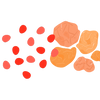
Frankincense for Anti-inflammatory
Frankincense demonstrates anti-inflammatory properties; its mechanism involves enzyme inhibition (cathepsin G), and specific formulations improve absorption of active compounds.
View More in Research HubResearch Interpretation
Frankincense, a resin obtained from various Boswellia trees, has garnered attention for its potential anti-inflammatory properties. Several clinical trials and randomized controlled trials (RCTs) have investigated its efficacy in treating inflammatory conditions. This exploration of frankincense's anti-inflammatory effects aims to provide an overview of the existing research, examining the evidence supporting its potential therapeutic role.
Protocols Studied in Research
[1] Topical frankincense extract oily solution for knee osteoarthritis. (Cited by: 1) (pmid: 36869332)
- Protocol: A randomized, double-blind, placebo-controlled trial compared topical frankincense extract to placebo in 70 knee osteoarthritis patients. Treatment was applied three times daily for four weeks.
- Outcome: Frankincense extract significantly reduced pain and improved function compared to placebo, as measured by WOMAC, VAS, and PGA scores.
[2] ArtemiC (artemisinin, curcumin, frankincense, vitamin C) for COVID-19 in hospitalized patients. (Cited by: 10) (pmid: 35587574)
- Protocol: A Phase II, placebo-controlled, double-blind, multicenter, prospective study randomized 50 hospitalized COVID-19 patients (2:1 ratio) to receive ArtemiC or placebo oral spray twice daily for two days, alongside standard care.
- Outcome: ArtemiC improved NEWS2 scores in 91% of patients, shortened durations of abnormal SpO2, oxygen supplementation, and fever. No treatment-related adverse events were reported, suggesting potential benefit in curbing COVID-19 deterioration.
[3] Boswellic acids (from frankincense) for inflammatory diseases. (Cited by: 23) (pmid: 19648270)
- Protocol: In vitro studies using a BA-affinity Sepharose matrix to identify BA targets, followed by in vitro enzymatic assays and in vivo studies assessing the effect of oral frankincense extracts on catG activity in human blood.
- Outcome: Boswellic acids potently and competitively inhibited cathepsin G (catG) activity, impacting neutrophil chemoinvasion and platelet Ca2+ mobilization. Oral frankincense extracts reduced catG activity in human blood, suggesting catG as a key target mediating frankincense's anti-inflammatory effects.
[4] Lecithin-formulated Boswellia serrata extract (CSP) vs. non-formulated extract (BE) for improving boswellic acid absorption. (Cited by: 9) (pmid: 27765357)
- Protocol: A randomized, cross-over study with 12 healthy volunteers. Participants received 2x250mg capsules of either CSP or BE in two periods, with a washout period between. Plasma boswellic acid concentrations were measured using LC/MS.
- Outcome: The lecithin formulation (CSP) showed significantly higher and faster absorption of most boswellic acids compared to the non-formulated extract (BE), reaching plasma concentrations sufficient for anti-inflammatory activity.
Research Interpretation: Summary and Conclusion
The provided studies utilized diverse methodologies to investigate frankincense's anti-inflammatory properties. One randomized controlled trial (RCT) demonstrated topical frankincense extract's efficacy in reducing pain and improving function in osteoarthritis patients, using validated outcome measures. Another study focused on the pharmacokinetics of boswellic acids, key components of frankincense, showing superior absorption with a lecithin formulation. In vitro studies identified cathepsin G as a key target for boswellic acids' anti-inflammatory action. While one study explored ArtemiC (a different substance) in COVID-19 patients, its inclusion highlights the broad interest in exploring natural compounds for health benefits. The consistent finding across relevant studies is the anti-inflammatory potential of frankincense, mediated at least in part through inhibition of cathepsin G. However, further research is needed to confirm these findings across various conditions and to optimize delivery methods for maximal efficacy. The variations in study designs and populations underscore the need for further investigation to fully elucidate the mechanisms and clinical applications of frankincense.
Publications
[1] Mohsenzadeh A; Karimifar M; Soltani R; Hajhashemi V (2023). Evaluation of the effectiveness of topical oily solution containing frankincense extract in the treatment of knee osteoarthritis: a randomized, double-blind, placebo-controlled clinical trial BMC research notes 16 (1) :28.
[2] Hellou E; Mohsin J; Elemy A; Hakim F; Mustafa-Hellou M; Hamoud S (2022). Effect of ArtemiC in patients with COVID-19: A Phase II prospective study Journal of cellular and molecular medicine 26 (11) :3281-3289.
[3] Tausch L; Henkel A; Siemoneit U; Poeckel D; Kather N; Franke L; Hofmann B; Schneider G; Angioni C; Geisslinger G; Skarke C; Holtmeier W; Beckhaus T; Karas M; Jauch J; Werz O (2009). Identification of human cathepsin G as a functional target of boswellic acids from the anti-inflammatory remedy frankincense Journal of immunology (Baltimore, Md. : 1950) 183 (5) :3433-42.
[4] Riva A; Morazzoni P; Artaria C; Allegrini P; Meins J; Savio D; Appendino G; Schubert-Zsilavecz M; Abdel-Tawab M (2016). A single-dose, randomized, cross-over, two-way, open-label study for comparing the absorption of boswellic acids and its lecithin formulation Phytomedicine : international journal of phytotherapy and phytopharmacology 23 (12) :1375-1382.

